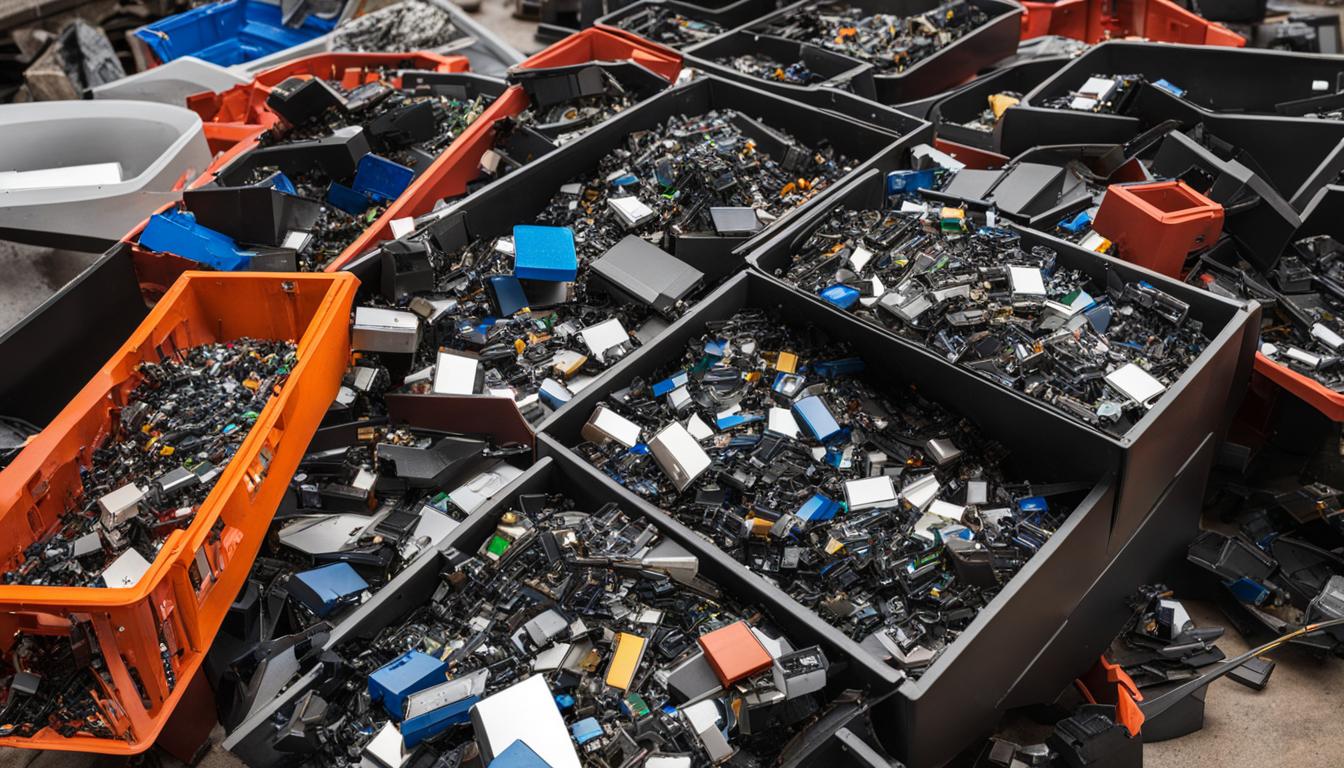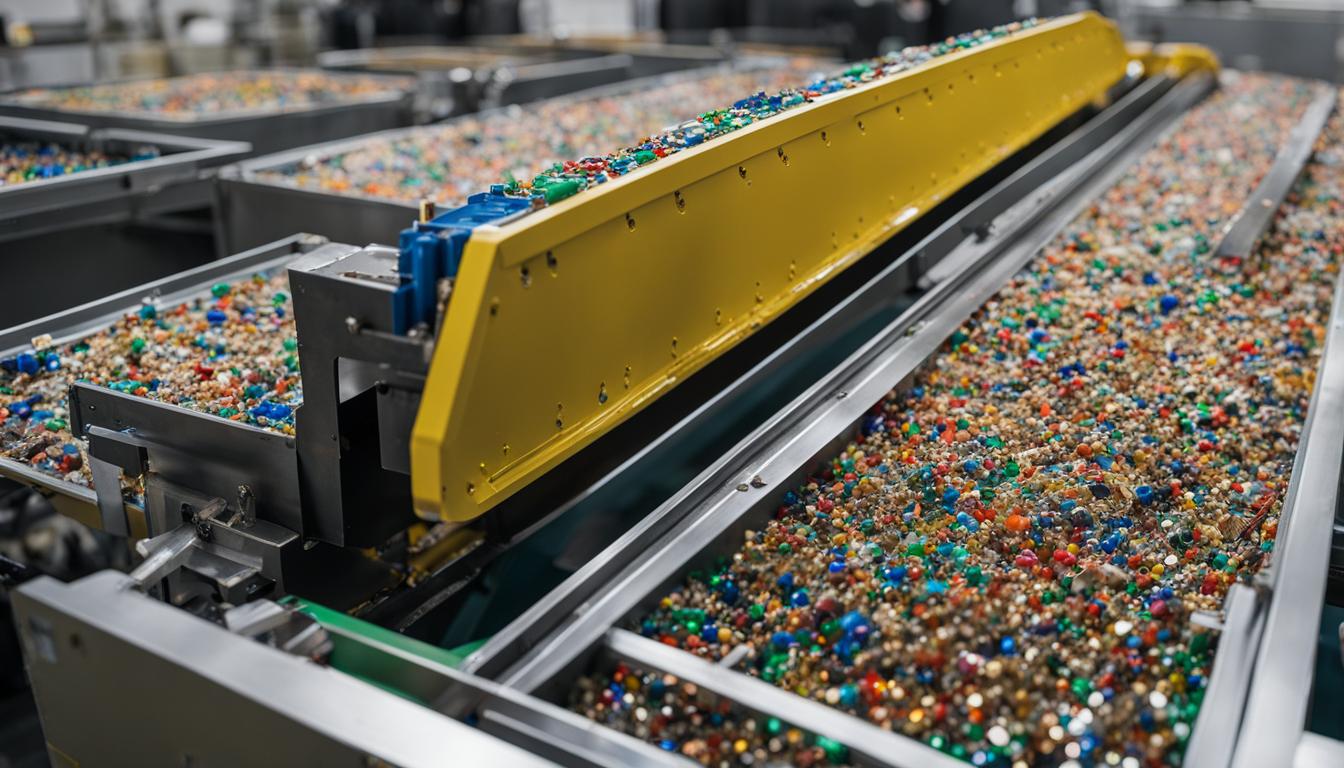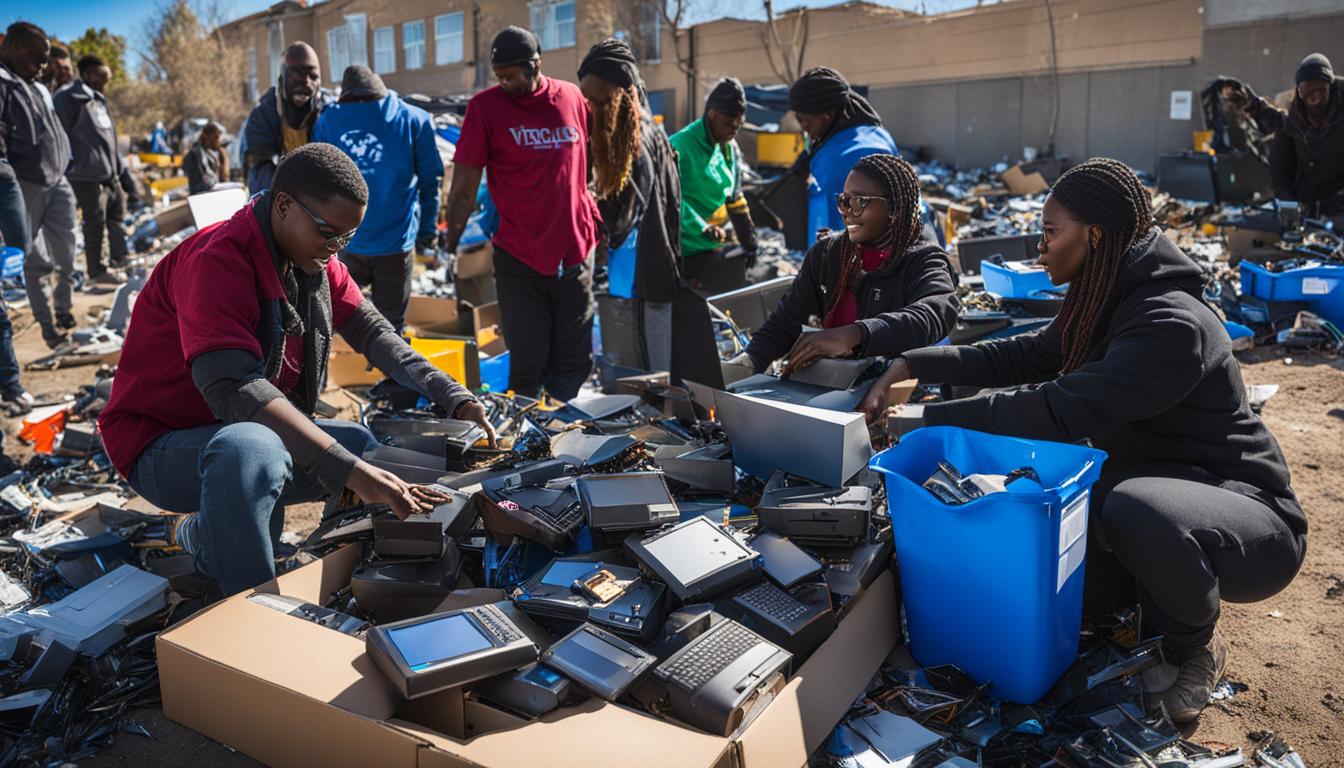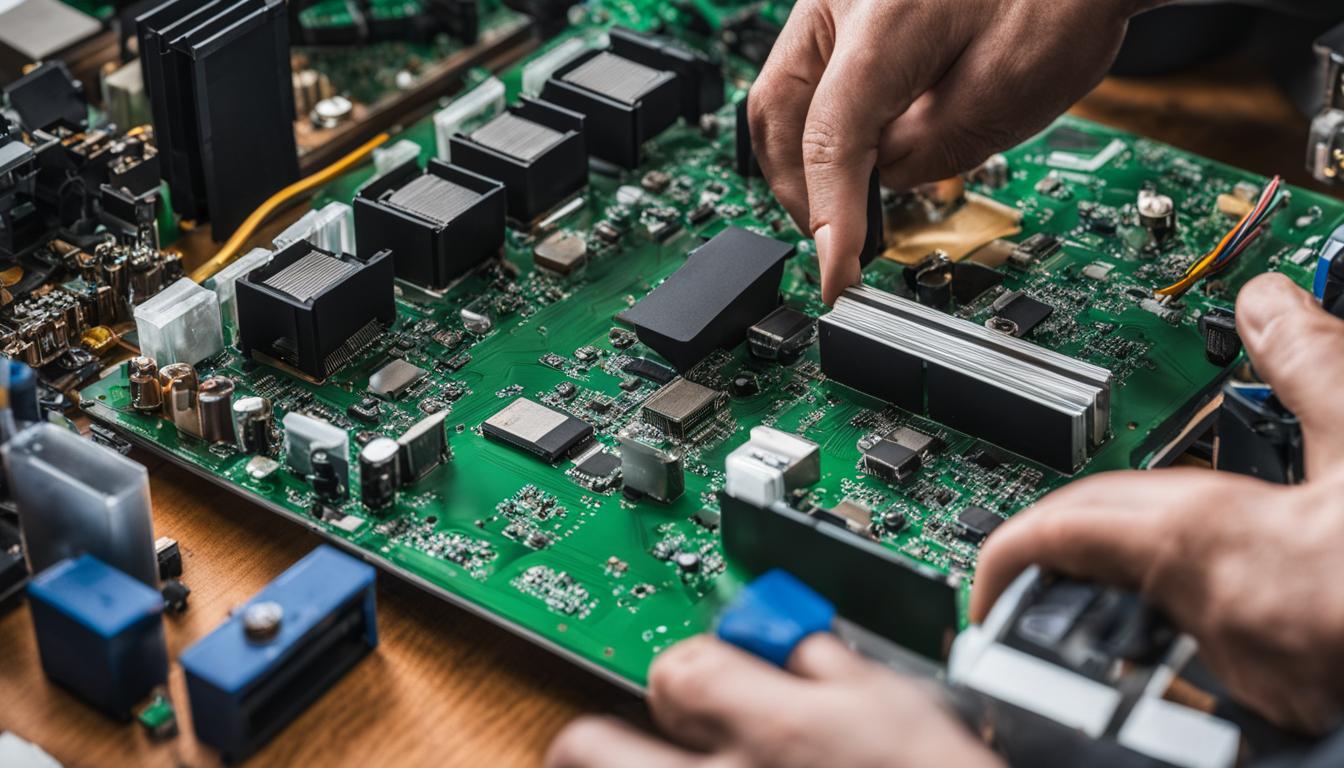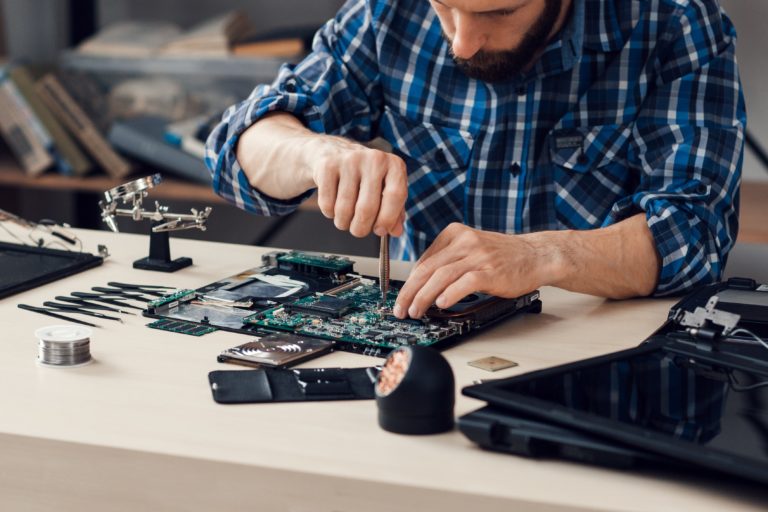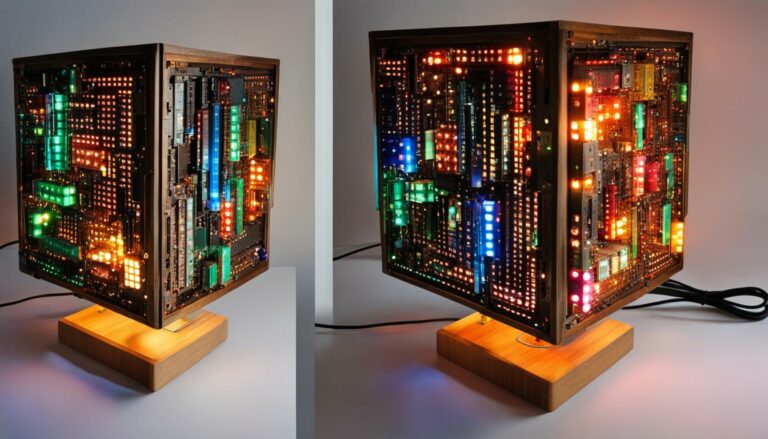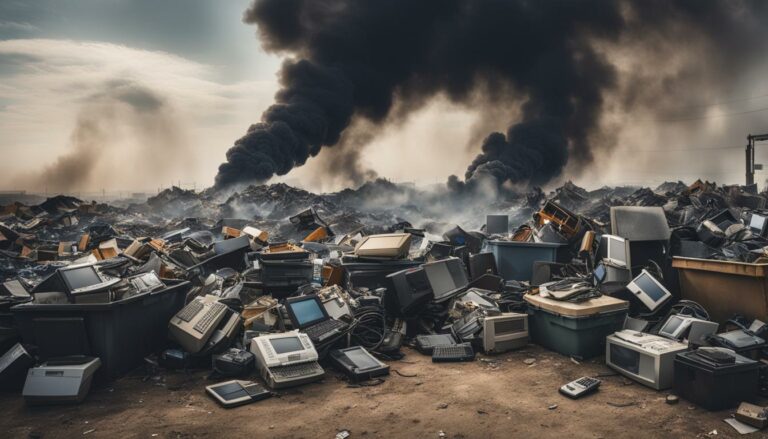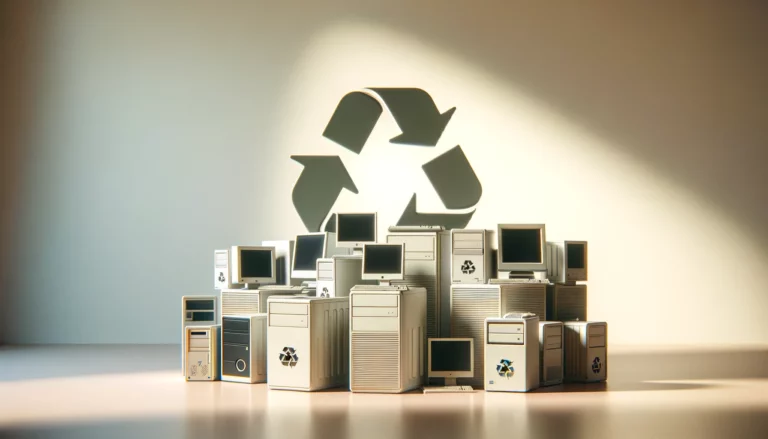Beyond Metals: Recycling Plastic Components in IT Hardware
IT hardware plastic recycling is a crucial aspect of sustainable IT solutions and eco-friendly IT disposal. As electronic waste, also known as e-waste, continues to increase, proper recycling of plastic components in IT hardware is vital for reducing its environmental impact. With millions of metric tons of e-waste discarded each year, it is essential to minimize the amount of electronics in landfills and recover valuable materials through recycling.
Key Takeaways:
- IT hardware plastic recycling is necessary to reduce the environmental impact of e-waste
- Proper recycling of plastic components in IT hardware minimizes electronics in landfills
- Recycling IT hardware allows for the recovery of valuable materials
- Sustainable IT solutions contribute to waste management and resource conservation
- Eco-friendly IT disposal supports a more sustainable and greener IT industry
The Importance of IT Equipment Recycling
IT equipment recycling plays a vital role in reducing the negative impact of electronic waste on the environment. By recycling old electronics, such as computers, laptops, and smartphones, valuable resources can be recovered and reused, reducing the need for raw materials and minimizing waste. Additionally, proper recycling ensures the safe disposal of harmful materials found in electronics, preventing environmental contamination. By supporting IT equipment recycling, businesses and individuals can contribute to creating a more sustainable future and support local communities through job creation.
Reducing Electronics in Landfills and Recovering Valuable Parts
Recycling IT equipment is essential in reducing the amount of electronics that end up in landfills. With the rapid advancement of technology, gadgets become obsolete quickly, leading to a significant accumulation of electronic waste. By recycling these devices, valuable parts such as circuit boards, capacitors, and connectors can be salvaged and reused in the manufacturing of new electronics. This not only reduces the strain on natural resources but also conserves energy and reduces carbon emissions associated with the production of new components.
Proper Disposal of Harmful Materials
Electronic devices contain various hazardous materials, including lead, mercury, and cadmium, which can be harmful to human health and the environment if not disposed of properly. Through responsible IT equipment recycling, these hazardous substances can be safely separated and disposed of according to regulations, preventing them from leaching into soil and water sources. This ensures the protection of both human and environmental health, reducing the risk of contamination and pollution.
Supporting Job Creation and Local Communities
IT equipment recycling not only benefits the environment but also creates employment opportunities and supports local communities. Recycling facilities and related industries require skilled workers to perform tasks such as dismantling, sorting, and processing electronic waste. By supporting and investing in IT equipment recycling initiatives, businesses can contribute to job creation and economic growth in their communities. Additionally, the recycling process often involves collaboration with local organizations and community outreach programs, further fostering a sense of responsibility and sustainability within the region.
| Benefits of IT Equipment Recycling | Employment Opportunities | Environmental Protection | Resource Conservation |
|---|---|---|---|
| Reduces electronics in landfills | Creates jobs in recycling facilities | Safely disposes of hazardous materials | Recovers valuable resources |
| Recovers valuable parts for reuse | Supports local community development | Prevents environmental contamination | Reduces the need for raw materials |
| Minimizes waste and carbon emissions | Contributes to a circular economy | Conserves natural resources | Promotes sustainability |
Materials Found in IT Hardware
IT hardware, such as computers and electronic equipment, is composed of a variety of materials. These include plastics, metals, glass, and precious metals. Plastics account for approximately 23% of a standard computer, while metals, both ferrous and non-ferrous, make up a significant portion as well. Certain components of IT hardware also contain precious metals like gold. Proper recycling of these materials is essential for their recovery and further utilization, reducing the need for extracting new raw materials and promoting sustainable practices.
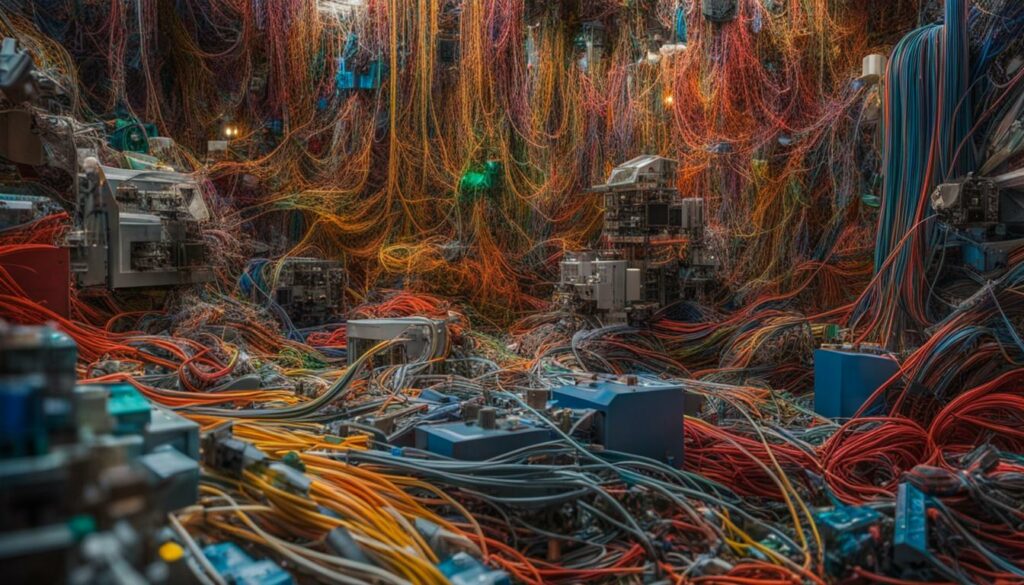
Here is a table summarizing the materials typically found in IT hardware:
| Material | Percentage Breakdown |
|---|---|
| Plastics | 23% |
| Ferrous Metals | 20% |
| Non-Ferrous Metals | 18% |
| Glass | 15% |
| Precious Metals | 4% |
| Other Materials | 20% |
Proper recycling of these materials ensures their recovery, preventing them from ending up in landfills and reducing the environmental impact of electronic waste. By extracting valuable resources from IT hardware, recycling initiatives contribute to resource conservation and promote a more sustainable approach in the IT industry.
Reusing Computer Parts
When it comes to IT hardware recycling, reusing computer parts is a sustainable and cost-effective solution. Many computer components can be repurposed and reused if they are still functional, extending their lifespan and reducing waste. By reusing computer parts, businesses and individuals can contribute to a more environmentally friendly IT industry.
One example of reusable computer parts is RAM (Random Access Memory). Instead of discarding old RAM modules, they can be removed from outdated computers and installed in new ones, providing a boost in performance without the need for new components. This not only reduces electronic waste but also saves money for businesses and individuals.
Another commonly repurposed computer part is the hard drive. Hard drives can be overwritten and reused or transformed into external storage devices. This allows for efficient data management and eliminates the need to purchase new storage solutions. By repurposing hard drives, valuable resources are conserved, and electronic waste is reduced.
Table: Examples of Reusable Computer Parts
| Component | Potential Reuse |
|---|---|
| RAM (Random Access Memory) | Installed in new computers |
| Hard Drive | Overwritten and reused or transformed into external storage |
| Keyboard and Mouse | Donated to charitable organizations or reused internally |
| Monitor | Reused internally or donated to schools and non-profit organizations |
In addition to RAM and hard drives, other computer components like keyboards, mice, and monitors can also be reused. These peripherals can be donated to charitable organizations or reused internally within a company. By extending the lifespan of computer parts through reuse, the demand for new components is reduced, resulting in less electronic waste and resource consumption.
Donating computers and equipment to charitable organizations is another way to support reuse and help those in need. By providing access to technology, individuals and organizations can bridge the digital divide and empower communities. It also ensures that functional equipment is utilized to its full potential, rather than ending up in landfills.
Recycling IT Hardware Components
When it comes to IT hardware recycling, various components can be recycled to recover valuable materials and reduce waste. These components include the CMOS battery, motherboards, CPU, hard drive, optical drive, and cables. Proper recycling of these components not only helps conserve resources but also prevents hazardous materials from polluting the environment.
The CMOS battery, commonly found in computers, contains hazardous substances such as lithium. It is crucial to ensure its proper disposal during the recycling process to prevent environmental contamination. Motherboards, on the other hand, contain precious metals like gold and silver, making them valuable for recycling. CPUs also contain valuable metals such as copper and can be recycled to recover these materials.
Hard drives, optical drives, and cables are other components that can be recycled. These components often contain materials like aluminum, copper, and plastic casing, which can be recovered and reused to reduce the demand for raw materials. By efficiently segregating and recycling these components, we can contribute to a more sustainable IT industry and help minimize electronic waste.
| Component | Materials |
|---|---|
| CMOS Battery | Lithium, other hazardous substances |
| Motherboards | Precious metals (gold, silver), electronic components |
| CPU | Metals (copper), ceramic |
| Hard Drive | Metals (aluminum, copper), plastic casing |
| Optical Drive | Metals (aluminum, copper), plastic casing |
| Cables | Metals (copper), plastic coating |
Proper segregation and recycling of these IT hardware components are crucial for resource conservation and environmental sustainability. By recovering valuable materials and reducing the demand for new raw materials, we can contribute to a more circular economy and minimize the environmental impact of electronic waste.
The IT Equipment Recycling Process
Proper handling and recycling of IT equipment is essential for minimizing the environmental impact of electronic waste. The IT equipment recycling process involves several stages to ensure the safe disposal of hazardous substances and the effective recovery of valuable materials.
Pre-processing
The first step in the IT equipment recycling process is pre-processing. This involves weighing and assessing incoming equipment to determine the most appropriate recycling method. Hazardous substances, such as batteries, are carefully removed to prevent environmental contamination. The remaining equipment is sorted based on material type, which allows for more efficient recycling.
Shredding
After pre-processing, the equipment undergoes shredding. Shredding involves breaking down the materials into smaller pieces, making it easier to separate different components. This step not only aids in proper material segregation but also ensures the destruction of any sensitive data that may be stored on the equipment.
Sorting
The final stage of the IT equipment recycling process is sorting. Various techniques, including magnets, eddy currents, infrared cameras, and air jets, are used to separate metals, plastics, and other materials. This step allows for the effective recovery of valuable materials for recycling and reuse. By sorting the materials, different components can be diverted to appropriate recycling streams, minimizing waste and maximizing resource conservation.
| Stage | Description |
|---|---|
| Pre-processing | Weighing and assessing equipment, removing hazardous substances, sorting based on material type. |
| Shredding | Breaking down materials into smaller pieces, destroying sensitive data. |
| Sorting | Using magnets, eddy currents, cameras, and air jets to separate metals, plastics, and other materials. |
What Happens to IT Recycled Products?
Once IT equipment is recycled and the materials are separated, they can be used to manufacture new products. Plastics, in particular, undergo advanced separation technology to produce clean streams of recycled plastic. These separated materials can then be used to make new electronics, reducing the demand for virgin raw materials and decreasing pollution and carbon emissions. The use of recycled materials in manufacturing aligns with the principles of a circular economy, promoting resource efficiency and waste reduction. Recycled commodities, such as metals and plastics, are valuable resources that can be reused in various industries.

Manufacturers process the recycled materials to meet industry standards and quality requirements. These materials are transformed into components and products that can be used in a wide range of applications. For example, recycled plastics can be utilized to make casings and enclosures for electronic devices, reducing the need for virgin plastic production. Recycled metals can be used in the manufacturing of new computer components, reducing the reliance on mining for raw materials. By utilizing IT recycled products, businesses contribute to a more sustainable and environmentally-friendly supply chain.
The manufacturing process of IT recycled products also provides economic benefits. Recycling and reusing materials create job opportunities in the recycling and manufacturing sectors. Local communities can benefit from employment and economic growth associated with recycling facilities and production plants. Moreover, utilizing recycled materials in manufacturing can lead to cost savings for businesses. By reducing the need for raw material extraction and production processes, companies can achieve cost efficiencies and improve their bottom line.
Table: Examples of IT Recycled Products
| Recycled Material | Examples of Recycled Products |
|---|---|
| Recycled Plastic | Computer casings, enclosures, keyboards |
| Recycled Metals | Computer components, circuit boards, connectors |
| Recycled Glass | Monitor screens, lenses |
| Recycled Cables | Networking cables, power cords |
In summary, IT equipment recycling plays a crucial role in creating a more sustainable future. By recycling and utilizing IT equipment materials, such as plastic and metal, to manufacture new products, businesses contribute to a circular economy and promote resource conservation. The use of recycled materials reduces demand for virgin resources, decreases pollution, and supports a greener supply chain. Moreover, the manufacturing of IT recycled products generates economic benefits by creating employment opportunities and reducing production costs. Embracing IT recycling practices is not only environmentally responsible but also economically advantageous.
Conclusion
IT Hardware Plastic Recycling is crucial for mitigating the environmental impact of electronic waste and shaping a sustainable future. By engaging in the recycling of IT equipment, we can recover and repurpose valuable materials, reducing the need for extracting new resources and minimizing waste. The implementation of proper handling and recycling processes ensures the safe disposition of hazardous materials, while also contributing to resource conservation.
Supporting IT hardware plastic recycling initiatives is vital for building a circular economy, where materials are reused and recycled to minimize waste and promote sustainability. By actively participating in these efforts, businesses and individuals can play a crucial role in creating a greener and more eco-friendly IT industry. Our collective commitment to waste reduction and resource conservation will pave the way towards a more sustainable future, benefitting both the environment and society as a whole.
Keywords: IT Hardware Plastic Recycling, environmental impact, sustainable future, resource conservation, waste reduction
FAQ
Why is IT equipment recycling important?
IT equipment recycling is important because it reduces the negative impact of electronic waste, prevents valuable resources from going to waste, ensures the safe disposal of harmful materials, creates employment opportunities, and supports local communities.
What materials are found in IT hardware?
IT hardware is made up of materials such as plastics, metals, glass, and precious metals like gold.
Can computer parts be reused?
Yes, many computer parts can be reused if they are still functional. Components like RAM can be removed from old computers and installed in new ones, while hard drives can be overwritten and repurposed.
Which components of IT hardware can be recycled?
Various components of IT hardware can be recycled, including the CMOS battery, motherboards, CPUs, hard drives, optical drives, and cables.
What happens during the IT equipment recycling process?
The IT equipment recycling process involves pre-processing, where equipment is weighed, assessed, and sorted. Hazardous substances are disposed of, and the remaining equipment is shredded. Sorting techniques are then used to separate different materials.
What happens to IT recycled products?
Once IT equipment is recycled and materials are separated, they can be used to manufacture new products. Plastics undergo advanced separation technology to produce clean streams of recycled plastic, which can be used to make new electronics.
Why should IT hardware plastic recycling be prioritized?
IT hardware plastic recycling is essential for reducing the environmental impact of electronic waste, minimizing the need for extracting new raw materials, and promoting resource conservation and waste reduction.

